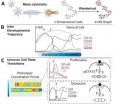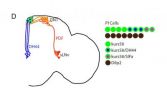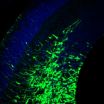(Press-News.org) HOUSTON – (April 24, 2014) – A team of international scientists led by Baylor College of Medicine has discovered a novel gene (CLP1) associated with a neurological disorder affecting both the peripheral and central nervous systems. Together with scientists in Vienna they show that disturbance of a very basic biological process, tRNA biogenesis, can result in cell death of neural progenitor cells. This leads to abnormal brain development and a small head circumference as well as dysfunction of peripheral nerves.
The study published today in the current issue of the journal Cell.
"This is the first human disorder associated with the gene CLP1," said Dr. Ender Karaca, post-doctoral associate in the department of molecular and human genetics at Baylor.
The gene find is significant because CLP1 has a role in RNA processing and has important implications for genomic approaches to Mendelian disease and for our understanding of human biology and brain development, Karaca said.
Karaca's work with families of this rare disorder began many years ago during his residency training as a clinical geneticist in Turkey.
A chance meeting with Dr. James R. Lupski, the Cullen Professor and Vice Chair of Molecular and Human Genetics and professor of pediatrics at Baylor, at a medical meeting in Istanbul, Turkey would lead to Karaca's recruitment as a trainee in Lupski's lab where the research took off and eventually the team unveiled new clues about the genetic malfunction that may be causing the disorder in these families.
Lupski leads the Center for Mendelian Genomics at Baylor, a joint program with the Johns Hopkins University School of Medicine that is funded by the National Human Genome Research Institute. The Center is focused on advancing research of the cause of rare, single-gene diseases usually called Mendelian disorders.
Using whole exome sequencing (a next generation test to analyze the exons or coding regions of thousands of genes simultaneously) conducted at the Baylor College of Medicine Human Genome Sequencing Center, the researchers identified CLP1 mutations in two unrelated families with the disorder.
The two families had distinct facial dysmorphic features that led Karaca to identify the gene in three additional families with very similar features.
"With the first families, we had no idea what gene might be causing this disorder, so we did a genome analysis and a good candidate gene screen came in with CLP1," said Karaca.
Based on his clinical knowledge of brain formation, he identified three additional families with very similar clinical and radiological features as the two families with confirmed CLP1 mutations.
"This time we sequenced the families for this specific CLP1 gene mutation and all had it," said Karaca.
But the identification of the mutation also brought new questions for the researchers that caused them to dig deeper into the gene.
"In all four families there were a total of eight people affected and now the problem is they all have the same gene mutated but one variant," said Lupski, the corresponding author of the report. "Ideally, we would have four families with the same gene but multiple types of mutations. This is sort of a polymorphism (a variation of unknown significance), so we started to think about other ways to obtain experimental evidence to support that this mutation was causative for the disease by doing functional studies on the variant."
Another chance encounter between Dr. Richard Gibbs, director of the Human Genome Sequencing Center at Baylor, and Dr. Josef Penninger, scientific director of IMBA, the Institute of Molecular Biotechnology of the Austrian Academy of Sciences in Vienna, who had a lot of interest already in CLP1 – and a mouse model to test new experiments with the gene – led to further discoveries of the importance of this gene.
"Penninger's mouse model had shown some of the similarities of the patients in the study with regard to the peripheral nervous system, but they had not identified brain malformation or small heads," said Lupski. "But when we showed them our patient data, they went back very carefully and looked, and indeed showed these same features."
It is remarkable that we used patient clinical information to enhance research and help guide experimental investigations then conducted in Vienna in their mouse model, said Lupski.
Penninger's team then could experimentally manipulate their animal model and further characterize this rare disease. "They answered key questions, and it became clear that this is not just a brain disease or a peripheral nerve disease; in fact, this spoke to some kind of neural stem cell progenitor problem," said Lupski. "The Vienna team of Dr. Javier Martinez, also a co-corresponding author on the study, could actually show that mutations in CLP1 affect tRNA biogenesis and that CLP1 mutant brain stem cells become more apoptotic (invoking cell death). The idea of neural progenitor or stem cell susceptibility to cell death may be a conceptual leap in the mechanism for a host of neurological disorders," said Lupski.
The invocation of cell death in this disorder would explain the clinical feature, the small heads caused by loss of nerve cells in the brain, the team found.
"This is a new way of thinking in the neurobiology field," said Lupski. "Basically it is a mutation that makes potential stem cells, or precursor cells, susceptible to apoptotic cell death pathways. So we have to start thinking about lots of diseases that might fall into this category, for example ALS (Lou Gehrig's disease)."
"As the Baylor-Johns Hopkins Center for Mendelian Genomics enters year three of our four year grant, we have found new learning opportunities with each phenotype," said Shalini Jhangiani, senior project manager in the Human Genome Sequencing Center and a co-author on the study. "To date we have over 350 phenotypes enrolled in our study with over 3,200 patient samples having undergone exome sequencing. The CLP1 story has raised expectations for future collaborative studies."
INFORMATION:
Baylor and the Institute of Molecular Biotechnology of the Austrian Academy of Sciences collaborated with a large team of scientists from around the world including: Rockefeller University in New York; Massachusetts General Hospital in Boston; Gaziantep Children's Hospital, Bezmialem University in Istanbul, Cerrahpasa Medical School of Instanbul University, and Instanbul Medeniyet University, all in Turkey; University Medical Center Hamburg-Eppendorf in Germany and the Medical University of Vienna.
Funding for this work was provided by: the National Institutes of Neurological Disorders and Stroke (R01NS058529, K23NS078056); the National Human Genome Research Institute (U54HG006542); the Astellas Foundation for Research on Metabolic Disorders; The Mochida Memorial Foundation for Medical and Pharmaceutical Research; Deutsche Forschungsgemeinschaft; Institute of Molecular Biotechnology of the Austrian Academy of Sciences and the European Research Council.
International collaboration unravels novel mechanism for neurological disorder
2014-04-24
ELSE PRESS RELEASES FROM THIS DATE:
Researchers create comprehensive map of human B cell development
2014-04-24
New York, NY - In the April 24, 2014 edition of Cell, a team of researchers led by Dana Pe'er at Columbia University and Garry Nolan at Stanford University describes a powerful new method for mapping cellular development at the single cell level. By combining emerging technologies for studying single cells with a new, advanced computational algorithm, they have created the most comprehensive map ever made of human B cell development. Their approach will greatly improve researchers' ability to investigate development in cells of all types, make it possible to identify rare ...
Surprising new insights into the PTEN tumor suppressor gene
2014-04-24
BOSTON – Ever since it was first identified more than 15 years ago, the PTEN gene has been known to play an integral role in preventing the onset and progression of numerous cancers. Consequently, when PTEN is either lost or mutated, malignant cells can grow unchecked and cancer can develop.
Now a team led by investigators at Beth Israel Deaconess Medical Center (BIDMC) helps explain more precisely how PTEN exerts its anti-cancer effects and how its loss or alteration can set cells on a cancerous course. The new study, which reveals that PTEN loss and PTEN mutations are ...
Researchers pinpoint protein crucial for development of biological rhythms in mice
2014-04-24
Johns Hopkins researchers report that they have identified a protein essential to the formation of the tiny brain region in mice that coordinates sleep-wake cycles and other so-called circadian rhythms.
By disabling the gene for that key protein in test animals, the scientists were able to home in on the mechanism by which that brain region, known as the suprachiasmatic nucleus or SCN, becomes the body's master clock while the embryo is developing.
The results of their experiments, reported online April 24 in Cell Reports, are an important step toward understanding ...
Oldest pterodactyloid species discovered, named by international team of researchers
2014-04-24
WASHINGTON—An international research team, including a George Washington University (GW) professor, has discovered and named the earliest and most primitive pterodactyloid—a group of flying reptiles that would go on to become the largest known flying creatures to have ever existed—and established they flew above the earth some 163 million years ago, longer than previously known.
Working from a fossil discovered in northwest China, the project—led by University of South Florida (USF) paleontologist Brian Andres, James Clark of the GW Columbian College of Arts and Sciences ...
Fruit fly study identifies brain circuit that drives daily cycles of rest, activity
2014-04-24
PHILADELPHIA - Amita Sehgal, PhD, a professor of Neuroscience at the Perelman School of Medicine, University of Pennsylvania, describes in Cell a circuit in the brain of fruit flies that controls their daily, rhythmic behavior of rest and activity. The new study also found that the fly version of the human brain protein known as corticotrophin releasing factor (CRF) is a major coordinating molecule in this circuit. Fly CRF, called DH44, is required for rest/activity cycles and is produced in cells that receive input from the clock cells in the fly brain. In mammals, CRF ...
Scientists find way to target cells resistant to chemo
2014-04-24
Scientists from The University of Manchester have identified a way to sensitise cancer cells to chemotherapy - making them more open to treatment.
The study published today in Cell Reports, could pave the way for the development of drugs to target cells that have become resistant to treatment.
The research team made the discovery whilst exploring the possible mechanisms behind resistance to chemotherapy drugs like Paclitaxel, often used to treat breast and colon cancer.
Dr Andrew Gilmore, who led the research team at The University of Manchester, is part of both the ...
New type of protein action found to regulate development
2014-04-24
Johns Hopkins researchers report they have figured out how the aptly named protein Botch blocks the signaling protein called Notch, which helps regulate development. In a report on the discovery, to appear online April 24 in the journal Cell Reports, the scientists say they expect the work to lead to a better understanding of how a single protein, Notch, directs actions needed for the healthy development of organs as diverse as brains and kidneys.
The Johns Hopkins team says their experiments show that Botch uses a never-before-seen mechanism, replacing one chemical group ...
Researchers discover new genetic brain disorder in humans
2014-04-24
A newly identified genetic disorder associated with degeneration of the central and peripheral nervous systems in humans, along with the genetic cause, is reported in the April 24, 2014 issue of Cell.
The findings were generated by two independent but collaborative scientific teams, one based primarily at Baylor College of Medicine and the Austrian Academy of Sciences, the other at the University of California, San Diego School of Medicine, the Academic Medical Center (AMC) in the Netherlands and the Yale University School of Medicine.
By performing DNA sequencing ...
Scientists reprogram blood cells into blood stem cells in mice
2014-04-24
BOSTON (April 24, 2014)—Researchers at Boston Children's Hospital have reprogrammed mature blood cells from mice into blood-forming hematopoietic stem cells (HSCs), using a cocktail of eight genetic switches called transcription factors. The reprogrammed cells, which the researchers have dubbed induced HSCs (iHSCs), have the functional hallmarks of HSCs, are able to self-renew like HSCs, and can give rise to all of the cellular components of the blood like HSCs.
The findings mark a significant step toward one of the most sought-after goals of regenerative medicine: the ...
To mark territory or not to mark territory: Breaking the pheromone code
2014-04-24
LA JOLLA, CA— April 24, 2014 —A team led by scientists at The Scripps Research Institute (TSRI) has deciphered the surprisingly versatile code by which chemical cues help trigger some of the most basic behaviors in mice.
The findings shed light on the evolution of mammalian behaviors—which include human behaviors—and their underlying brain mechanisms.
"How does an individual respond differently to the environment based on experience? How does it distinguish itself from others? These are some of the fundamental questions that a study like this one helps us address," ...






